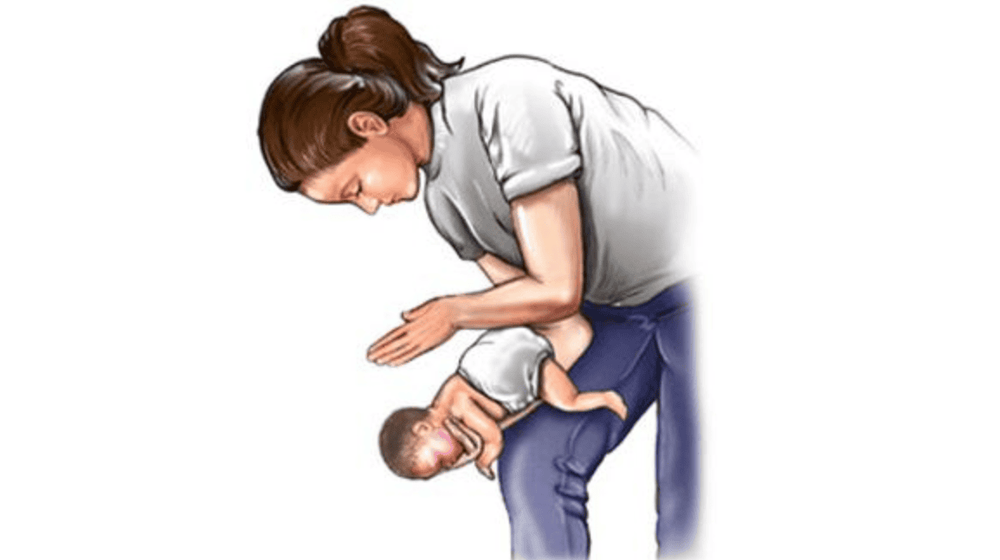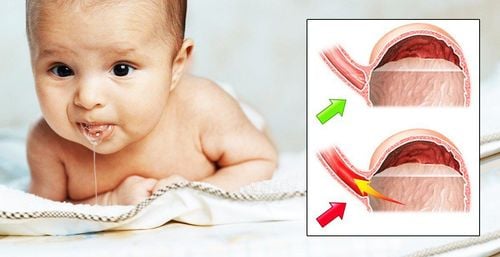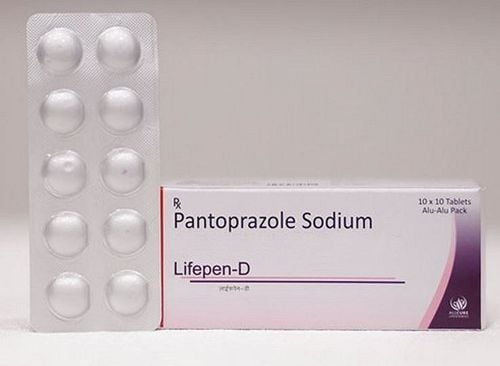This is an automatically translated article.
Newborn regurgitation is not so uncommon. Parents need to pay attention to learn about the cause of this symptom and know how to handle it when the baby vomits.
1. Why do babies vomit for a long time?
Vomiting is a condition in which the contents of the stomach (milk, food and gastric juice) are pushed out through the mouth (under the influence of stomach contractions and contractions of the abdominal wall muscles). Regurgitation is a condition in which the reflux of substances from the stomach through the pharynx to the mouth occurs due to the mere contraction of the stomach. Regurgitation is common in infants, often accompanied by belching.
Causes of vomiting in infants are:
1.1 Physiological causes Newborns have immature digestive systems. Located between the esophagus and stomach is the cardiac sphincter, whose job is to contract to help prevent food from backing up from the stomach into the esophagus. In infants, because the sphincter muscles are not fully developed and the baby's stomach is often horizontal compared to adults, the stomach volume is small, so the baby is prone to spitting up (especially when the baby eats too much). This condition resolves on its own within the first year of life.
1.2 Mistakes in how to feed and care for children Parents who feed their babies too much, feed them too much or force them to eat beyond the threshold Feeding babies in the wrong position or improperly bottle-feeding so children are swallowed a lot Gas in the stomach and cause vomiting The baby who has just had a full meal is placed immediately The child moves and plays a lot during and after eating The baby's diaper is too tight or the baby's umbilical cord is too tight 1.3 Due to medical problems The child has certain medical conditions. upper respiratory tract infection The baby has a neurological infection (purulent meningitis) The child has increased intracranial pressure (cerebral hemorrhage due to a decrease in prothrombin ratio) The child has adrenal genitourinary syndrome The child has inflammatory bowel disease, no Tolerance to milk The child has autonomic dysfunction (pyloric spasm). 1.4 Due to surgical diseases Gastrointestinal malformations: Congenital duodenal stenosis, diaphragmatic hernia, pyloric stenosis, according to the esophagus (baby often presents with vomiting in the first days of birth) Intestinal obstruction, torsion Intestinal: Often accompanied by systemic infection, sepsis - defecation, abdominal distention, bloody stools, black brown gastric juice,...

Bệnh lý ngoại khoa tắc ruột có thể khiến trẻ sơ sinh nôn trớ nhiều
2. How to handle when the infant vomits?
As soon as the child vomits or spits up, parents need to put the baby's head to one side so that the baby does not choke on vomit. Then, parents quickly clean the vomit in the baby's mouth, throat and nose (clean the mouth first - nose later) by sucking or wrapping gauze on their fingers and absorbing all the vomit in the child's mouth and throat. Next, the parents cupped their hands and patted them on the back to reassure the baby and help the baby cough up any remaining vomit in the throat.
When the baby has finished coughing and vomiting, the parents wipe the baby's neck and body with warm water, change the clothes contaminated with vomit for the baby. After that, parents give the baby warm water or warm oresol (take it in small spoonfuls), breastfeed and bottle-feed the baby slowly. Finally, put the child to sleep, do not use antiemetics unless prescribed by the doctor and monitor the baby's next sign of vomiting.
3. How to handle if the child is choking on vomit - foreign body in the airway?
When the baby is choking on vomit - foreign body: If the baby breathes in vomit, parents should not try to pick up the vomit with their hands, but need to do the Heimlich maneuver immediately to help expel the foreign body from the airway. After the vomit is expelled, if the child is still tired, the child should be taken to the nearest medical facility.
2 Heimlich method used is:
Heimlich patting the back: Parents support the child to lie on their stomach with one hand, the hand raises the child's head - the child's neck is lower than the child's body, using the other hand to pat the child on the back 5 times (between the baby's shoulder blades) Heimlich presses the chest: Parents support the child lying on his or her back with one hand, the hand supports the head - the child's neck is lower than the child's body, quickly sucking out the spilled milk in the nasopharyngeal area. baby (if any) and then use 2 fingers of the other hand to press firmly on the middle area under the baby's breast 5 times. After that, check if the baby has expelled all the vomiting, can combine back patting - chest compression.

Trẻ sơ sinh nôn trớ nhiều hoặc sặc chất nôn trớ có thể áp dụng Heimlich vỗ lưng
4. How long does it take to care for a regurgitated newborn?
If an infant vomits due to mistakes in eating and caring (functional vomiting), parents need to adjust their diet and take care of the baby and then continue to monitor the child's regurgitation at home. home. If a child has a pathological regurgitation, parents need to take the child to a medical facility for quick, timely and effective diagnosis and treatment.
In case the child spits up due to mistakes in eating and caring, parents should pay attention to properly care for the child as follows:
The mother needs to breastfeed the baby with the correct posture, latch on to the breast properly. Slowly and with enough frequency, do not force the baby to eat too full. If the baby eats a mixture, the mother should know how to make milk, give the baby a bottle. When the baby is full, you need to hold the baby, burp and place the baby properly. . Pay attention not to hold the baby or play with him when he has just eaten. Massage around the baby's navel gently to reduce stomach contractions and limit vomiting. It is possible to massage the abdomen strongly and deeply along the path of the colon to increase intestinal peristalsis, increase fluid secretion, help the baby excrete stool regularly and reduce abdominal distension and vomiting. If, after adjustment, the vomiting condition does not improve, accompanied by unusual signs such as fever, constant crying, convulsions, lethargy, continuous vomiting, vomit with bile (green, yellow) or blood,... then parents should take the child to a medical facility immediately. In general, parents should closely monitor, not be subjective when seeing an infant vomiting for a long time. If the baby has strange signs, parents should take the baby to the doctor as soon as possible. Parents should also apply the above tips to limit the baby's vomiting, regurgitation and avoid the unfortunate consequences of choking on vomit.
Please dial HOTLINE for more information or register for an appointment HERE. Download MyVinmec app to make appointments faster and to manage your bookings easily.













